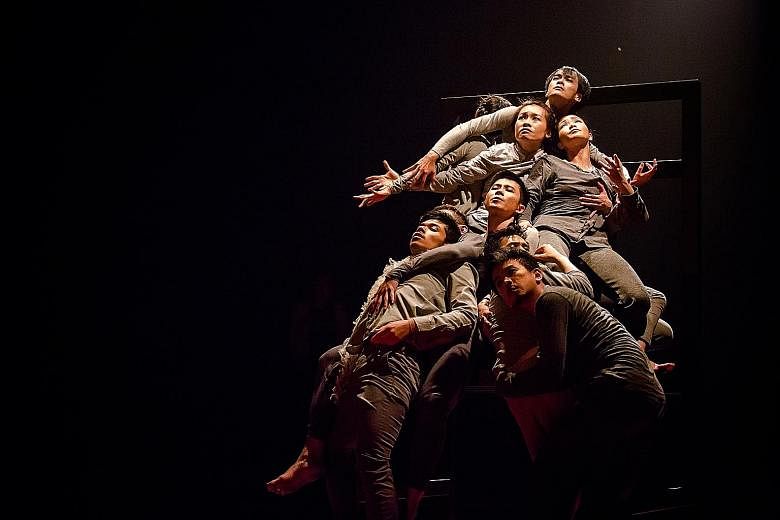REVIEW / DANCE-THEATRE
CUT KAFKA!
T.H.E Dance Company and Nine Years Theatre
Esplanade Theatre Studio/ Last Thursday
Kafka's surreal world of metamorphosis and transformation creates a canvas that is expertly exploited in this collaboration.
Added to the mix of iconic Kafka-esque imagery, such as continual references to insects, the dance theatre choreography also delves into the artist's life and philosophy. A projected script translates a voiced narrative in Mandarin interspersed by a sound score.
The audience views the action up-close in a four-sided seating arrangement above a blood-red floor and lights suspended like a spiderweb on overhead red pipes creating an intense atmosphere of hyper-reality.
In a seamless blend of voice and movement, the performers probe the physical, emotional and spiritual state of the mind through clever cross-references to extracts of Kafka's text.
The world in reverse is the opening image. Balancing tables on their heads, the performers cluster as if bearing the weight of the mundane world on their shoulders.
Trapped within a nightmare of restrictions, they state their frustrations with not being able to transform as if this would lead to freedom, revelations of their talents, and optimism.
Writing is a key leitmotif and is referenced through gestures denoting writing on hands, bodies and available surfaces, including over-sized furniture that constantly shifts in motion and meaning.
The significance for Huayiemerges not only through the Mandarin script, but in revelations of Kafka's interest in Chinese philosopher Lao Tzu, particularly the central notion of transformation.
The performers huddle together gathering energy, converse about their progress, writhe in broken, fragmented forms with body parts twisted.
Toes and elbows are bent backwards, necks and spines distorted, and fingers clawed to denote inner turmoil.
This repeated formula is over-stated and some deeper individual investigation, stillness and layering would have added a counter-point.
Episodes intrude on the larger theme, like trying to rescue a cat fallen down a drain - a metaphor for saving people and the world. In another scene, the performers move robotically in a de-humanising transformation.
The dancers also ascend a massive chair that becomes a platform for revolution and a climb to power, that is eventually crashed to the floor to return to an egalitarian landscape that blocks and constricts the protagonists.
While characters emerge from these small bursts of fantasy into reality, the show remains a thesis on an inner convolution and collision of dreams and imaginings. The final scene of white-coated surgeons clustering around the operating table is apt, resonating with a continuum of life and death.
The two companies synergise voice and movement, diminishing the differences in their theatre and dance backgrounds. This confluence created a powerful rendering of the themes.
Strong direction and a clear intention between the collaborators enabled a sophisticated, innovative work that engaged the audience.
Like a Taoist circle of life, Cut Kafka! embodies transmigration of East and West in a provocative response to the Czech writer's work.
Correction note: An earlier version of the article referred to Franz Kafka as a German writer. He is Czech. We are sorry for the error.

